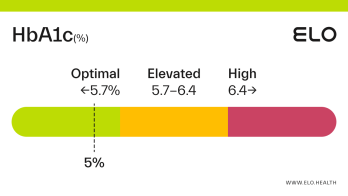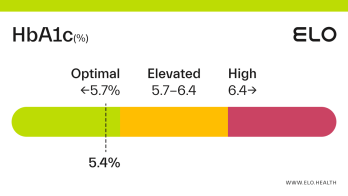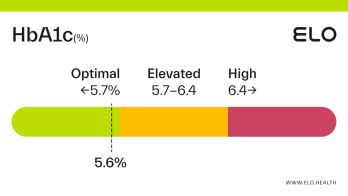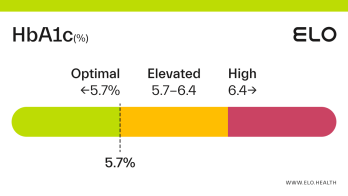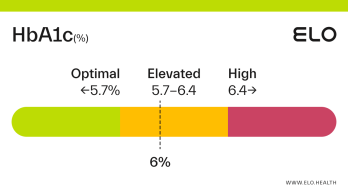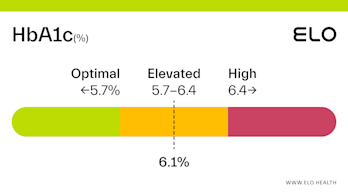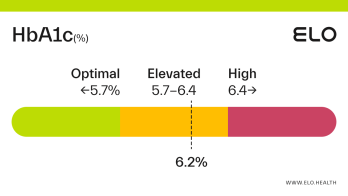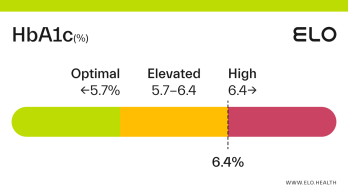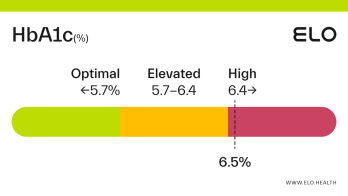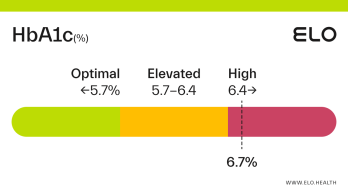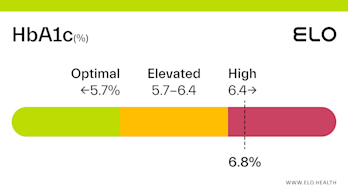HbA1c: 5.8
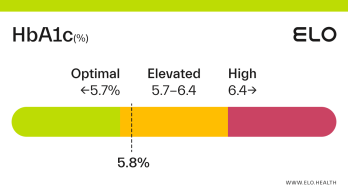
What does an A1c level of 5.8 mean? Are there any symptoms associated with this level?
An A1c level of 5.8 means that 5.8% of the hemoglobin in your blood is saturated with sugar.
An A1c of 5.8 is considered elevated and means your blood sugar levels have been raised over the last few months.
Elevated A1c levels of 5.7-6.4 percent are considered prediabetes. The higher your A1c, the greater your risk for developing diabetes.
If your A1c is elevated, diet and lifestyle changes may be effective for getting your levels back into the optimal range without the need for medications. Lowering your A1c back into the optimal range (4-5.6%) can prevent or delay diabetes in the future.
An A1c of 5.8 doesn't usually have any symptoms. One possible sign of prediabetes is a darkening of the skin and sometimes skin tags on certain parts of the body including the neck, armpits, elbows, knuckles, and knees.
It’s important to know the symptoms of diabetes. These include increased thirst, frequent urination, excess hunger, unintentional weight loss, fatigue, and/or blurred vision.
Factors that could contribute to an A1c level of 5.8:
A variety of factors can affect A1c levels. Some of these include:
Diet, particularly those high in refined carbohydrates and added sugars, and low in fiber
Overweight/ obesity
Sedentary lifestyle
Age
Race (people of Black, Hispanic/Latino, American Indian, Asian American, or Pacific Islander descent are at greater risk for prediabetes/ diabetes.)
Stress
Use of certain medications, including a type of steroid called glucocorticoids
Genetics (family history of pre-diabetes or diabetes)
Adherence to your prediabetes/ diabetes management plan
Pregnancy
Chronic disease/ inflammation
Several things can also falsely increase or decrease your A1c result. Some of these include:
Kidney failure, liver disease, or severe anemia
Certain medicines, including opioids and some HIV medications
Blood loss or blood transfusions
Early or late pregnancy
A less common type of hemoglobin found in people of African, Mediterranean, or Southeast Asian descent, as well as people with blood disorders like sickle cell anemia or thalassemia
Let your doctor know if any of these apply to you to determine if you need follow-up testing.
What to do if your A1c level is 5.8?
Adopting healthier habits and making changes to your diet can help lower your A1c levels back into the optimal range, and potentially prevent or delay a progression to diabetes. To lower your A1c:
Be active every day: Aim for 150 minutes of moderate physical activity per week (about 30 minutes 5 days per week).
Fill half of your plate with non-starchy veggies at every meal, and incorporate a source of lean protein and plant-based fat to assist with blood sugar control.
Limit refined carbohydrates and added sugar, and choose whole-grain carbohydrates such as whole wheat bread/ pasta, quinoa, farro, and steel-cut oats, instead.
Lose excess weight if you are overweight or obese
Manage stress and get adequate sleep to help balance hormone levels that can impact blood sugar
Medications used to improve A1c results
Although the American Diabetes Association and the Endocrine Society recommend a medication called metformin for the treatment of prediabetes, medications are typically not prescribed for an A1c level of 5.8.
This is likely because individuals with prediabetes are not at risk for developing the more serious microvascular complications of diabetes. Also, roughly two-thirds of people with prediabetes do not develop diabetes, even after many years, and one-third of people with prediabetes are able to lower their A1c back into the optimal range without medication [5].
For this reason, diet and lifestyle changes are typically recommended in lieu of medications for the management of prediabetes.
References
All About Your A1C. (2018, August 21). Centers for Disease Control and Prevention.
https://www.cdc.gov/diabetes/managing/managing-blood-sugar/a1c.html
Diabetes Risk - What Causes Diabetes. (n.d.). American Diabetes Association. Retrieved September 14, 2021, from
https://www.diabetes.org/diabetes-risk
Cherney, K. (2020, June 18). A Complete List of Diabetes Medications. Healthline.
https://www.healthline.com/health/diabetes/medications-list
Pani, L. N., Korenda, L., Meigs, J. B., Driver, C., Chamany, S., Fox, C. S., Sullivan, L., D'Agostino, R. B., & Nathan, D. M. (2008). Effect of aging on A1C levels in individuals without diabetes: evidence from the Framingham Offspring Study and the National Health and Nutrition Examination Survey 2001-2004. Diabetes care, 31(10), 1991–1996.
https://doi.org/10.2337/dc08-0577
Davidson M. B. (2020). Metformin Should Not Be Used to Treat Prediabetes. Diabetes care, 43(9), 1983–1987.
https://doi.org/10.2337/dc19-2221

